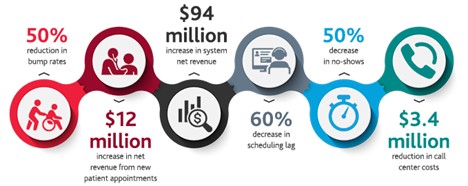
Optimizing Patient Access: A Checklist
Enhancing Care Quality and Efficiency in Healthcare
At its core, patient access is about ensuring patients have access to high quality care and information they need in a timely and efficient manner.
From a provider perspective, patient access is essential for efficient practice operations, balancing patient demand with clinical resource productivity, managing patient populations and successfully managing value-based contracts.
Patients are increasingly demanding digital options for care access. According to BDO’s 2022 Patient Experience Survey, 81% of U.S. patients have used a patient portal. Of those that use patient portals, 87% find them helpful. According to BDO’s 2024 Healthcare CFO Outlook Survey, 98% of healthcare organizations are already piloting generative AI programs, and 47% of CFOs expect to increase their spending on technology implementation in the next 12 months. For providers to be successful, this investment in technology should offer the access options that patients prefer.
To ensure patients receive the care they need, provider organizations need to be as easy to navigate as possible. To that end, providers need to analyze key patient-facing systems and tap stakeholders to evaluate performance and implement digital solutions, including patient self-scheduling and online patient symptom evaluation. With the right digital tools, providers can expand patient access to both online and onsite care.
Improving patient access across an organization can be overwhelming. Fortunately, there are actions providers can take now to achieve immediate results for both onsite and virtual care: improve scheduling templates, refine referral strategies and upgrade call centers.
Why Should I Optimize Patient Access?
Organizations that optimize their patient access experience significant benefits. Some of the results clients have achieved include:

Scheduling Template Optimization
A positive patient experience relies on timely access to clinical services, which requires appointment scheduling and registration to be as seamless as possible. Providers who optimize their scheduling templates can support patient self-scheduling, which reduces call center costs and improves the overall patient experience.
In addition, scheduling template optimization allows for a better digital front door experience by enabling patients to take control of their care from the comfort of their smartphone or computer. Finally, scheduling template optimization is also critical for patient retention and practice growth.
Those looking to improve their scheduling templates should start here:
1. Review your current scheduling templates. As you review, ask yourself the following questions:
- Does the provider practice in more than one department?
- Which appointment types does the provider use?
- How long is each appointment type scheduled?
- Which appointments, if any, must happen on a certain day or at a certain time?
- Which appointments, if any, should occur within a few days of scheduling?
- Which appointments, if any, currently have a longer-than-desired lead time?
- How many appointments are scheduled per slot?
2. Revalidate the current rationale behind your templates. Your review should focus on three components:
- Template design assessments
- Template standards and maintenance policies
- Scheduling protocols, such as policies for productivity, use of blocks, bumps and session limits
3. After you’ve completed your reviews, implement adjustments to your scheduling templates to address identified gaps and inefficiencies.
4. Evaluate updated scheduling templates for ease and accessibility by testing the patient portal and call center.
5. Finally, identify and rebook displaced patients to minimize disruption to your patient population.
Improve Referral Strategy
Poor referral strategies often lead to the dreaded “referral blackhole” where patient care is compromised due to a lack of follow-up care. Improving workflows through an optimized referral process and scheduling patients through a “Work Queue” optimization improves patient retention and makes care easier on the part of the provider.
When seeking to improve your referral strategy, here are a few key steps:
1. Identify the KPIs you want to track to measure the efficacy of your referral strategy.
2. Assess your current referral policies and procedures to identify gaps.
3. Standardize your referral policies and procedures. In particular, you should focus on standardizing the following:
Internal and external referral management
Referral communication
Authorization and documentation
Operational reporting
4. Based on this standardization, implement consistent and streamlined referral workflows, supported by your health information technology system (ex. Epic).
5. Establish governance for your referral management standards/accountability.
6. Train your clinicians and front-office staff in the new referral process.
7. Take advantage of advanced decision tree solutions if your available technology platforms allow.
Optimize Call Center
A provider’s call center is often the first and last point of contact for patients. If a call center experience is frustrating or confusing, it discourages patients from returning to seek care.
To optimize your call center, consider taking these steps:
1. Review performance data, call center structure and the organizational goals tied to the success of the call center.
2. Engage stakeholders, including patients and staff, to understand the current state of the call center.
3. Use operational and benchmark data and stakeholder feedback to define KPIs.
4. Improve software, workflows, and tools to help boost patient engagement, call quality and call efficiency.
5. If your technology platforms allow, implement decision tree solutions to expand patient self-scheduling and enhance call center workflows.
6. Pilot a staffing model for an optimized call center before it goes live.
7. Provide implementation support and training before and after the optimized call center goes live.
8. Continue to regularly evaluate key performance indicators.
Don’t Wait to Optimize Patient Access
A good patient experience is essential to the financial health of any health system. Providers that are invested in improving the patient experience need to ensure they are making it as easy as possible for patients to access care.
Beyond providing easy access to appointments and referrals, providers should strive for a “zero touch” experience where patients can seamlessly pay bills, check-into appointments, access health records, review visit notes, request prescription refills and communicate with their clinicians. Optimizing scheduling templates, refining referral strategies and improving call center experiences are great first steps to improving patient access.